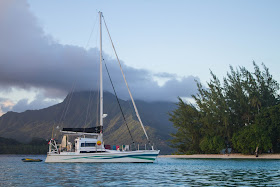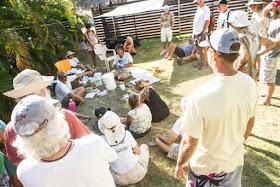Are You Settling In?
Do you miss the boat?
We’re asked this a lot. And I think the questions mean
something different to every person who asks. In some cases people assume that
we’ve given up an indolent life of beaches and BBQ’s to embrace one where we need
to get up everyday, on a schedule, and wear shoes (just like everyone else,
sucker.) Other people are curious about how we’re navigating the changes in
cultures and values, or settling into expensive urban living, or simply staying
warm. Behind every question is a bit of ‘why on earth would you give that up?’
combined with ‘I knew you’d come back.’
So, ya, we miss the boat. But maybe not for the reasons you
might imagine.
Long ago, during one of our forays into shore life, we
realized that separating our life into sailing and not sailing was a false
divide. There are absolutely some big differences; we’re not floating, we’re
not able to sail to windward and the neighbours we go to sleep next to are
typically still there when we wake up. But the big things that we love about
cruising; friendship, living simply, exploration and adventure aren’t boat
dependent, they’re actually lifestyle choices.
Over our 16-years onboard we’ve had lots of conversations, with
a lot of different types of people, about what makes life aboard special. For
many people it came down to the fact that living aboard is an uncomplicated way
to live intentionally. Simply put, cruising is a lifestyle that emphasizes
connection and shies away from consumerism. It’s just easier to spend time with
your neighbours and not glorify consumption when 1) you and your neighbours
have time for each other and 2) there’s nothing to actually buy (and nowhere to
put it).
Some of my most-loved cruising moments are the connections
we’ve made with people we might not have ever met. We’ve had the chance to
befriend a much wider circle of friends than we might otherwise have: how else
could I have ended up with friends who range in age from teen-ish to 70ish and
who come from almost every continent in the world? Another thing I grew to love
were the spontaneous gatherings that came together organically. One of my
recent favourites was an Easter celebration for the boat kids in La Cruz:
 |
| Spontaneous dinner out |
 |
| saying goodbye to our special life |
Because several families were around, one of the mums
offered to boil some eggs while another said she’d bring homemade dyes. This
doesn’t sound too atypical for Easter—but from that casual offer, a complete
party came about. Without any back-and-forth,
or planning. Me and another mum bought chocolate to hide along with the
eggs and came up with a simple craft. The older kids helped the younger kids
without prompting and everyone spent the afternoon playing together. I couldn’t
help but think that a similar ‘land’ party would need to be shoe-horned into
busy lives and would probably be made stressful with way too many details.
Being too busy is
one of the markers of modern adulthood and it’s the lifestyle choice we most
want to avoid. It’s also the hardest one to avoid—because being busy is so
wrapped up with our sense of being successful. The perception is if you have too
much any free time on your hands, clearly you aren’t living a full life.
But the full life we just spent eight years nurturing emphasized the value of
spontaneity. I love spur of the moment adventures and find having to plan to
make a plan is a bit soul destroying.
The weird thing though is no matter how little time we have
for each other, North Americans seem to have plenty of time to shop. I recently
read that the US has 23.5
square feet of retail space per person (the next highest was16.4 square feet in
Canada and 11.1 square feet
in Australia —Europe is down in the 2 foot range). Living space in much
of Africa is less than this.
Happily, unlike avoiding becoming too busy to spend time
with old and new friends—not shopping is an easy one for us. Currently we’re
living in a furnished sublet—surrounded by someone else’s stuff (which turns
you off of acquiring things in a big way). We’re also broke. So this means
we’ve been turning to thrift shops and craigslist for everything we need and I
can honestly say—we’re hooked.
 |
| Alma told me how molas are made and talked parenting with me |
 |
| the Sri Lankan fishermen danced and sang after trading for fish |
So there’s lots to miss about the boat—also lots not to miss
(don’t miss those boat chores and I love flush toilets, easy access showers
& washing machines). But the aspects that make living aboard so special for
me aren’t just boat-life things. They’re just a little easier for boat people.
















































